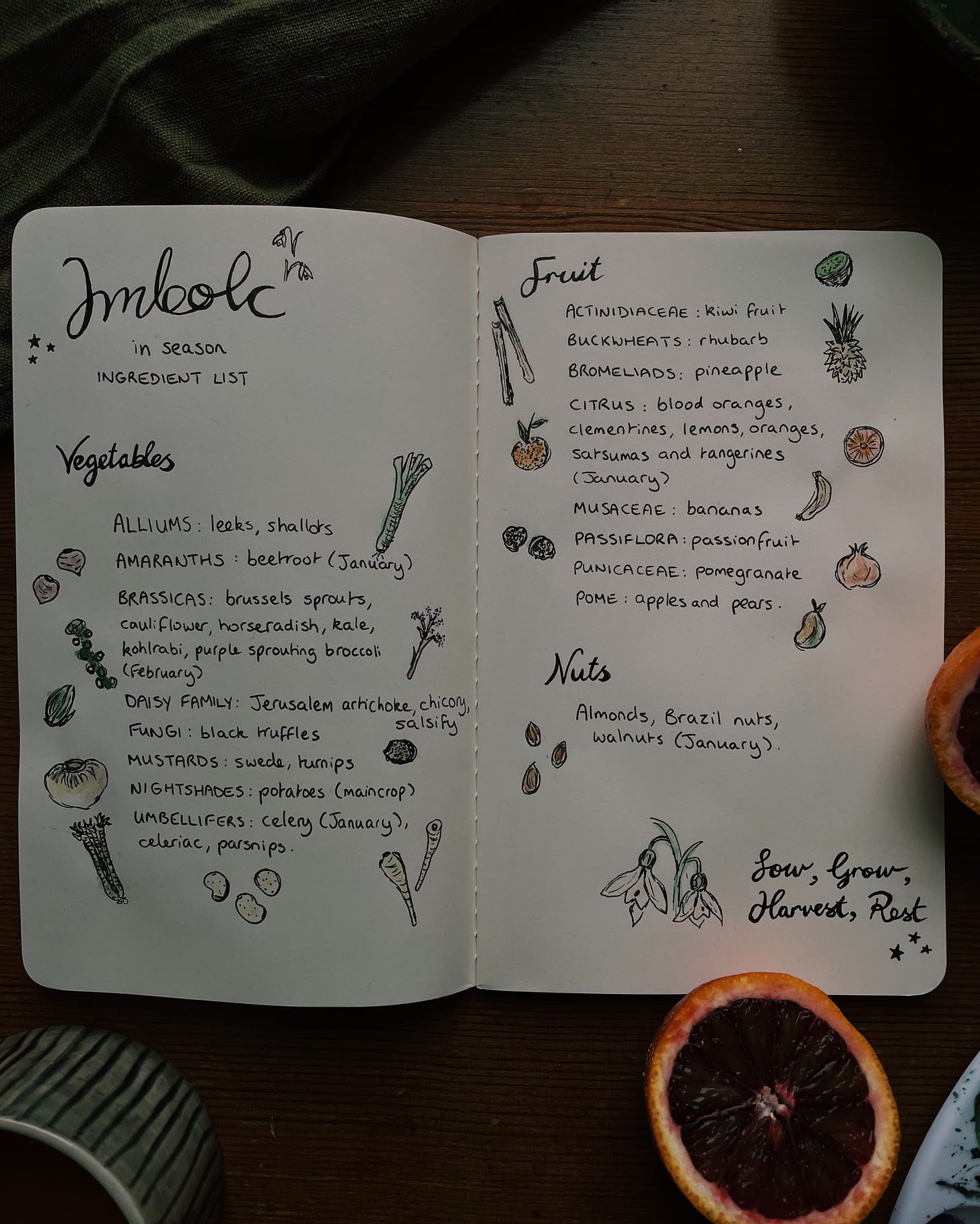Eating seasonally, and opting for local and organic produce where possible, is at the core of the slow food movement - something I’m passionate about all year round. There’s a surprising abundance about this period of deep Winter in the lead-up to Imbolc, mainly thanks to brassicas, roots and tropical fruits that appear just when we need them - as if they knew. Here’s my illustrated list of in season ingredients for this time of year in the Northern Hemisphere and five tips to make the most of delicious deep Winter produce.
Vegetables:
Alliums: leeks, shallots.
Amaranths: beetroot (January).
Brassicas: brussels sprouts, cauliflower, horseradish, kale, kohlrabi, purple sprouting broccoli (February).
Daisy family: Jerusalem artichoke, chicory, salsify.
Fungi: black truffles.
Mustards: swede, turnips.
Nightshades: potatoes (maincrop).
Umbellifers: celery (January), celeriac, parsnips.
Fruit:
Actinidiaceae: kiwi fruit.
Buckwheats: rhubarb.
Bromeliads: pineapple.
Citrus: blood oranges, clementines, lemons, oranges, satsumas and tangerines (January).
Musaceae: bananas.
Passiflora: passionfruit.
Punicaceae: pomegranate.
Pome: apples and pears (January).
Nuts: almonds, Brazil nuts and walnuts (January).
Five tips to make the most of Imbolc produce:
At this time of year, I often find myself simultaneously craving lighter fare filled with veggie goodness and cosy comfort food. Nutritious soups and stews tick both boxes. To avoid them becoming boring, I like to add flavour twists to a hearty base, such as fruit or interesting spices. Celeriac pairs beautifully with apple (I love Flora Shedden’s recipe in ‘Gatherings’) and citrus lifts everything (try adding more lemon juice than you would think to a go-to dhal recipe). Preserved lemons add zing to stews and I always make my staple lentil soup with a generous spoonful of rose harissa to give a warming Winter kick. Textured toppings add variety and all-important bite – whether toasted nuts and seeds, tofu fried in soy sauce or crispy fried kale with chilli flakes.
Avoiding food waste is important all year round, but after Christmas there tends to be a wee bit of sad looking veg kicking around at the bottom of the fridge or back of the larder. Past-their-best Brussels sprouts make a lovely soup with leftover chestnuts – simply peel, chop roughly and boil rapidly so they don’t lose their colour and blend with chestnuts then thin down with a little milk and vegetable stock. Reserve a few chestnuts to crumble and fry in butter and sage as a garnish.
Speaking of nuts, fresh nut season is coming to an end. Pickled nuts are a retro preserve that’s coming back into fashion. I first tried pickled walnuts at Edinburgh foodie institution Twelve Triangles: the preserve balances salty, bitter and sweet beautifully and goes so well with a cheeseboard or cold meats. To make your own, start by soaking the nuts in a salt solution for a week or so before drying them out for another few days – they will blacken but don’t be alarmed. Pack the nuts into sterilised jars and cover with a pickling liquor made with a ratio of 1 litre malt vinegar: 6 tablespoons soft brown sugar and any spices you fancy – I like black pepper and all spice – and seal immediately. Leave to mature.
A tropical fruit pavlova can be just the ticket at this time of year, bringing a little sunshine to celebratory bakes. A basic meringue recipe has a ratio of 50g caster sugar to every egg white; beat the whites until stiff peaks, then add the sugar a teaspoon at a time until fully combined and dissolved into the mixture. Bake in a low oven for an hour and a half and leave to cool overnight. Fill with whipped cream flavoured with vanilla extract and a little icing sugar to taste, then cover with an abundance of any tropical fruit you can get your hands on.
The first shoots of purple sprouting broccoli can be found in just a few weeks’ time, like a herald of Spring to come - and a much-needed burst of colour on dinner plates. Like all brassicas, my favourite way to eat them is burnt! Fry over a medium heat until cooked through and charred at the edges. Serve with a sprinkling of orange zest and toasted almonds as a tasty side dish.
It’s always porridge season in my house, but in the depths of Winter I find there are few things more comforting. Like soup though, it can get a wee bit boring after a while so to mix things up I often introduce baked porridge at weekends when I have longer to linger over breakfast. Chopped dates, grated apple or chopped pear, cinnamon and cardamom make great additions to baked oats. For every 50g of oats add an equal quantity of nuts and dried fruit, a handful of fresh fruit, and 5 tablespoons of milk (you can make this with oat milk too). Give everything a good mix, add a sprinkling of your chosen spices then transfer to a greased baking dish. Soak for ten minutes to speed things up, then bake for 20 minutes at 180C or until the mixture is set and golden.







Baked porridge tomorrow morning sounds lovely. Must do this. Just looking at the seasonal list (so useful!) How about a chicory blood orange and feta salad? Maybe with a few almond and a simple dressing. Hmm then what for dinner. Soup :)